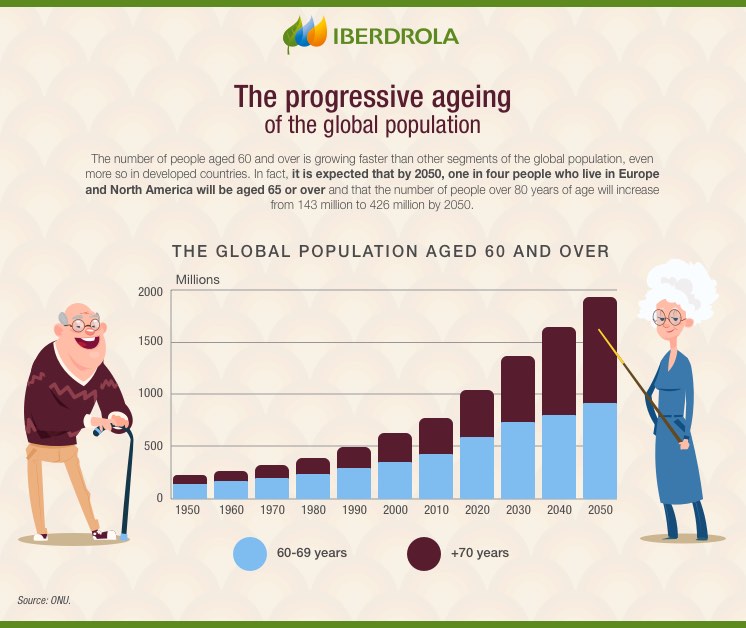Ageism
Ageism: the UN has signalled that age discrimination is a worldwide problem
Older people often don't feel any different, but they suffer from discrimination, a phenomenon called 'ageism', which can lead to social isolation and deteriorating physical and mental health. That's according to the United Nations Global Report on Ageism, published in March 2021, which urges swift, efficient strategies to address the problem.

One in two people in the world discriminate against the elderly. This malady, known as ageism, damages people's physical and mental health and well-being and can lead to social isolation. That's according to the Global Report on Ageism published by the United Nations that underscores that this is a global problem and calls for urgent action to fight against what it calls its "devastating toll on society".
What is ageism (WHO)
The World Health Organisation (WHO) defines ageism as the stereotypes, prejudice and discrimination directed towards others or oneself based on age. . In other words, ageism arises when age is used to categorise and divide people in ways that lead to harm, disadvantage and injustice and erode solidarity across generations. This does not affect older people alone, since there is no question that both older and younger people suffer from ageist attitudes.
Although other organisations have raised the retirement age to 65, the World Health Organisation considers people aged 60 and over to be "elderly". This perception of ourselves and others may be due to our increased life expectancy, particularly in highly developed societies, which does not, however, mean that globally speaking, ageism is not pervasive in different spheres: health, society, the economy, etc.
The nature of ageism: Institutional ageism refers to the laws, rules and social norms of institutions that unfairly restrict opportunities and systematically disadvantage individuals because of their age. Interpersonal ageism arises in interactions between two or more individuals, while self-directed ageism occurs when ageism is internalised and turned against oneself.

SEE INFOGRAPHIC: The progressive ageing of the global population
Ageism in the workplace
The workplace is probably the most ageist environment at present. For example, older people are often totally excluded from recruitment processes. In other cases, they suffer from isolation or unfair treatment because it is assumed they are less dynamic, find it more difficult to adapt to change and have difficulties understanding technologies, etc. "We cannot let age-based stereotypes, prejudice and discrimination limit opportunities to secure the health, well-being and dignity of people everywhere,” said Dr Tedros Adhanom Ghebreyesus, WHO Director-General during the event to launch the report.
Consquences of ageism (examples)
Ageism has an impact in different areas. These include:
Health
Ageism is associated with worse health, speeding up mental and physical decline, which in turn lead to a worse quality of life and lower life expectancy. It is calculated that 6.3 million cases of depression worldwide are attributable to this malaise.
Society
Ageism exacerbates social isolation and loneliness. There is a tendency to undervalue older people even in the family environment, their lives are taken over and they are not included in decision-making, which reduces their independence and self esteem.
Economy
Ageism increases the risk of poverty and financial insecurity. What's more, sometimes older people do not have access to certain advantages and services, such as insurance, mortgage loans and others, because of their age.
Love
Ageism restricts older people's ability to express their sexuality. One reason for this is that love between older people is viewed with prejudice and because society still treats the topic as a taboo subject.
You are likely to be a witness to or guilty of ageism at some time. You may not be aware that you are doing it, because of the culture you have inherited and it may be unintentional. For example: believing that someone is unable to tackle new challenges because of their age, being condescending or ignoring their opinion or experience for the same reason, using disparaging terms when talking about older people - which causes a lower opinion of them as a group or treating them as sick or dependent by definition.
How to eliminate ageism
Can ageism be eliminated? The answer is yes. Although ageism has a cultural component that may take some time to change, social, political and business policies can be established to effectively reduce or eliminate this form of discrimination. Several studies have already shown that strategies to reduce ageism in the workplace can open up opportunities to create very valuable intergenerational teams for companies. A report published by consultancy firm Deloitte in 2020 claims that "seventy per cent of organisations say that multigenerational workforces are important or very important for their success".
The UN report mentioned above establishes three strategies for addressing ageism:
- Establish useful policies and laws to reduce ageism against all age groups.
- Interventions can be implemented across all levels of education, from kindergarten to university.
- Encourage intergenerational contact to reduce prejudice and stereotypes between age groups.
To boost the effects of these strategies, it is recommended: scientific research into ageism be supported with the objective of better understanding and addressing the phenomenon, investment is made in the abovementioned strategies to achieve a real change for the population and to measure their efficacy, and a political and civil movement is created able to change the discussion on age and ageing.
This is not a new phenomenon, which is why some countries have already enacted legislation. For example, in the United States, the Age Discrimination in Employment Act forbids age discrimination against people who are aged 40 or over. Other proposals promoted by governments and social organisations include: analyse advertisements for job vacancies to search out discriminatory attitudes, encourage active ageing as an opportunity to overcome stereotypes against older workers and encourage a culture that appreciates the talents of senior people by means of activities based on knowledge transfer and mentoring.




